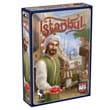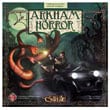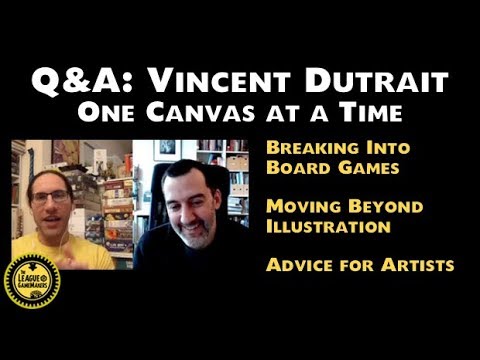
Most boardgames have random elements. It could be something small like player order or available resources at setup. Where that random element is placed in a game could dramatically change how that game works and feels to your players. Let’s examine a few games and how random is placed in the design of a turn.
 Kingdom Builder (Euro)
Kingdom Builder (Euro)
- Random: Card for available playing spots is drawn
- Decision: Where to place houses (including special powers)
 Talisman (American)
Talisman (American)
- Random: Dice roll
- Decision: Which space to go based on die roll
- Random: Card is drawn
- Random: Card is encountered based on roll or situation
 Istanbul (Euro)
Istanbul (Euro)
- Decision: Movement and encounter
- Random: Encounter some spaces rolling dice or Bonus cards (not all spaces have a random element)
 Arkham Horror (American)
Arkham Horror (American)
- Decision: Move up to a predefined number of spaces
- Random: Encounter or Combat
- Decision: Place a Ship on any space on the board
- Random: There are cards present that are drawn randomly, but present a sub-area of decision making (more on this later)
This is fun! I could do this all night. Before you jump in with technicalities, I’m aware that there are other possibilities in many of these games during a turn depending on the circumstances. I am laying out the most basic turn structure to make a point. The point is this.
WHERE YOU PLACE RANDOM IN A GAME’S DESIGN CHANGES EVERYTHING.
First let’s look at all the places random can be placed.
- SetupSome random setup in a game is required. If not, then you have the exact same game each time. The important thing to keep in mind here is, how much of a random factor do you want in setup and is it balanced for all players? Player order is something to consider first. In most games, there is a random player order established. Depending on the game, this can set up players with a starting advantage. Mechanics should follow to readjust for balance when this happens. For instance, in Tokaido or Merchants of Venus, players not starting first or second get extra money to balance the advantages the starting players get.Other forms of setup random placement are opportunities that all players have the chance to take advantage. In Lords of Waterdeep, for example, the four Quests laid on the board and available buildings to buy is the random setup that all players have a chance to use.However, in Lords of Waterdeep, players are also given their own Quests and Intrigue cards that only they may use. This is another type of random setup in which only one player has access to the opportunity. It’s not unlike random character powers or abilities.
When choosing how a game’s random works in setup, you’re choosing how fast or slow players can get ahead or fall behind. Be mindful of how the player will feel if they start the game at a disadvantage due to a misplacement of random in the setup of the game.
- Before decisions are madeMost Euros follow this pattern, but not all (see Istanbul). Essentially, you are asking the player to make a decision based on the random event. In Kingdom Builder, for instance, your first move is to draw a random terrain card. You can then make the decision to place your buildings in certain places that have that terrain. You can also use powers that you’ve earned along the way to place in other ways, but all decisions are based on that one random card.In Merchants of Venus (arguably not Euro), your movement is decided by 3 dice. You then make decisions based on that random factor. You sometimes repeat the random by drawing a new alien race, but then you are, again, making decisions based on that random card.Both of these games are great examples of how a game feels when random comes before the decision making process.
- After decisions are madeThe games that follow this pattern are usually more theme or story driven. In this case, a random event happens based on decision. In Betrayal at House on the Hill, for example, players decide where to move based on a set Speed number. When they explore a new area, they pull a random room. That room then sets off another random event by requiring the player to draw a card. Those cards can sometimes continue to create more random events by requiring the player to roll dice to see what happens. This random outcome can continue to create a random end-game-situation. This is an extreme case, but you can see how an entire game can change based on one uninformed decision.Many people dislike games with this much of a random outcome, thus the need to coin the phrase “ameri-trash”. It’s seen as lazy design, but I disagree with that assumption. Some games are more story centered rather than puzzle decryption. There’s room for both types of games on my shelves. Sometimes I want to be challenged, and sometimes I just want to be entertained. If you want a more “what will happen next” feeling to a game, then consider this approach in designing how players run into the random elements of your game.Not all games that follow this approach are story-driven or even American style. Istanbul, for instance, has a random element after the decision to move depending on where you choose to move. A player has the choice to avoid or mitigate these random elements though, which is why it’s not considered to be an American-style game I believe. The player still has control on what type, if any, random is introduced to their turn.
- End of GameSome games have random elements that effect final scoring or who wins in other ways. This is rare, mostly because random events at the end of a game can make a player feel like their efforts were pointless. There are many ways to mitigate this though. In Dungeon Lords, when fighting the final battles, you don’t know what magic spells will come up and change, dramatically, what the outcome of the game can be unless… unless the players have taken it upon themselves to mitigate that random event by choosing to look ahead at those cards or by avoiding the magic users when getting heroes. The game gives players a way to cancel or at least mitigate that random element.In my own game, Asking for Trobils, I took a risk in making the random bonus cards come up in the end. We mitigated this effect, however, by making sure that the points given by them were very little, and we allow players to see the cards one at a time so they have a chance to react to them (all except that last one). Still, we made sure to play test this element more than anything else in the game because of its placement in the design of the game.In short, it’s tricky to add a random element at the end, but if you do, make sure it’s not a game changer.
BEYOND THE FOUR AREAS OF PLACEMENT I MENTIONED, THERE ARE SUB-AREAS WHERE RANDOM PLACEMENT CAN REALLY MAKE A DIFFERENCE.
Remember the description I gave of how random works in Betrayal at the House on the Hill? The biggest complaint of that game is that it’s “too random”. There’s no sense of control or decision making that results in predictable outcomes. In short, it’s basically a story you’re all reading together. To some that’s a broken design, but it’s not. As I said, it’s just a preference for what type of game you’d like to play. How would you alter it to bring some of those “it’s too random” people back to the table?
You alternate the random elements. Remember when I described the turn, it was: decision, random, random, possible random. What if instead, it was: decision, random, decision, random, possible random.
In the game you can choose to walk into an unexplored room (decision). Then you draw a room tile (random) which instructs you to draw a specific type of card (random) which then either stops your turn or asks you to roll dice (possible random).
If we change that second random (draw a specific card) to decision, you now have a different game. In other words, when you enter a random room, you’re given the choice to either draw the card specified on the room tile, or continue on to another room tile. This means you’ll get to pick and choose what types of cards you draw. What does this do to the game? Now the game has lost some of its storytelling theme. You skip a lot of random events that give a lot of the story, however, the player feels a little more in control of their fate.
Obviously, the designers of this game wanted players to feel out of control and come across insane stories that were beyond their ability to change. That is, actually, the feeling you’d have in a “real” haunted house.
It’s not about the amount of random that gives a game its feel, it’s the placement of the random elements. As an exercise, I task you to take that game you’re working on right now (or at least thinking about working on) and identify where you’ve placed the random elements. What happens when you move them around? What happens when you mitigate the random or give players a chance to avoid it? What happens when you take away their choice at all?
Playing with where the random elements are placed in a game is a great exercise for a designer.









